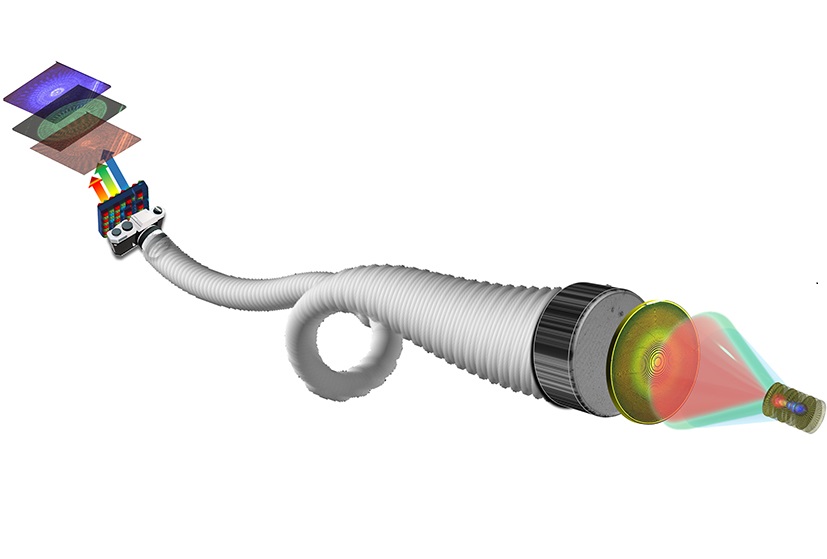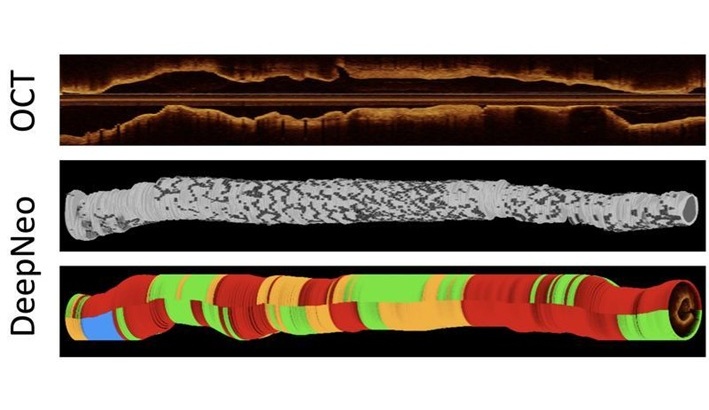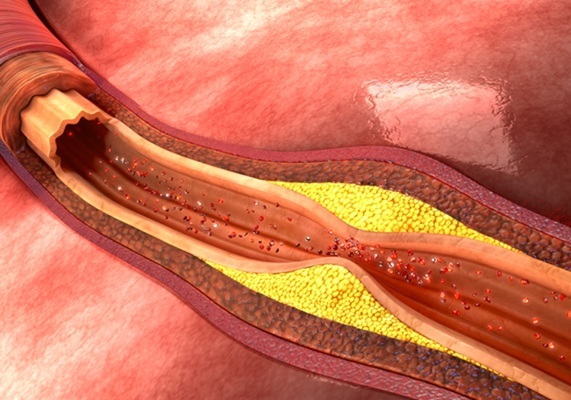New Lens System for Endoscopes Offers Physicians Unprecedented View of Inside the Body
|
By HospiMedica International staff writers Posted on 18 Nov 2024 |

The human body is a network of complex, interconnected passageways that traverse the cardiovascular, respiratory, and digestive systems. For physicians, reaching and treating diseased or damaged tissues within these narrow, winding arteries, bronchial tubes, and gastrointestinal chambers can be a daunting task. Many of these pathways are not only small in diameter but can also narrow to microscopic sizes, making it challenging to access them for treatment. Medical devices used to navigate and view these areas need to be flexible, maneuverable, and equipped with a light source. One such device is an endoscope—a long, thin, flexible tube that carries light, and often a camera, at its tip. Endoscopes have long been a vital tool for detecting, viewing, and treating various medical conditions such as blood clots in the heart, airway obstructions, and early-stage colon cancer.
However, current endoscopes are not without their limitations. The size of many endoscopes used today is too bulky to reach smaller spaces within the body, like the arteries in the brain or the bronchioles in the lungs. The size constraint is primarily due to the camera lens and light source needed at the tip of the device, which are essential for detecting, viewing, and treating diseased tissue. In response, researchers have now designed an innovative lens system that could allow physicians to better view and treat areas deep inside the body. The researchers have engineered a metalens—a flat, lightweight optical component that manipulates light through microscopic nanostructures. Metalenses have a wide range of applications in various technologies where space is limited, such as in smartphone cameras.
The tiny, flat metalens designed by the research team at the University of Washington’s Department of Electrical & Computer Engineering (Seattle, WA, USA) could shrink the diameter of the smallest endoscopes by more than 50%. This reduction would allow doctors to access deeper, hard-to-reach areas within the body. The system is incredibly small, with an aperture width of just 0.5 millimeters, about the width of five human hairs side by side. The new metalens system uses quantitative phase imaging, a microscopy technique that measures the phase of light as it passes through a sample, and depth sensing to generate a real-time, full-color, three-dimensional video with minimal computational requirements. While research has explored the use of quantitative phase imaging and depth sensing in other contexts, their application in endoscopic procedures is a unique and innovative development.
Another novel feature of the optical system is the use of chromatic aberration for depth sensing and 3D imaging. Typically, chromatic aberration is seen as an optical flaw that causes colored fringes in images due to a lens's failure to focus all colors at the same point. However, the team found a way to turn this imperfection into an advantage. By using a tiny, flat metalens, they created a chromatic splitting effect, causing each color to converge at different depths. This longitudinal rainbow effect allows depth to be mapped into the color channels of a camera. The results of this study, published in Nature Light: Science & Applications, show that an endoscope with such a lens system could provide real-time visual feedback to physicians, improving the efficiency, accuracy, and success rate of medical procedures. The system also offers higher resolution and better contrast than X-rays without the harmful radiation exposure.
This breakthrough opens up the possibility for physicians to access previously unviewable areas, such as deep blood clots in the brain or diseased arteries throughout the body, including in the heart. This is a promising development, particularly for treating cardiovascular diseases like heart attacks and strokes, which are the leading causes of premature death worldwide. Having developed a proof of concept, the research team now plans to build a prototype to test in a physical model of a human organ. The meta optics technology they have created can be manufactured and scaled up, presenting a unique opportunity to bring this lens system to the medical market. They also aim to guide the technology through clinical trials over the coming decade and beyond.
“We are trying to extend the eyes of the surgeon or the physician deeper into the body,” said Eric Seibel, a UW research professor in mechanical engineering, who co-authored the paper and has been engineering endoscopes for decades. “This is an application of meta optics that has the potential to make a practical impact in everybody’s lives, with a significant amount of development work. It may take 20 more years to make that impact. But it’s a technology that has great potential, and everyone should start paying attention to it.”
Latest Surgical Techniques News
- DNA Origami Improves Imaging of Dense Pancreatic Tissue for Cancer Detection and Treatment
- Pioneering Sutureless Coronary Bypass Technology to Eliminate Open-Chest Procedures
- Intravascular Imaging for Guiding Stent Implantation Ensures Safer Stenting Procedures
- World's First AI Surgical Guidance Platform Allows Surgeons to Measure Success in Real-Time
- AI-Generated Synthetic Scarred Hearts Aid Atrial Fibrillation Treatment
- New Class of Bioadhesives to Connect Human Tissues to Long-Term Medical Implants
- New Transcatheter Valve Found Safe and Effective for Treating Aortic Regurgitation
- Minimally Invasive Valve Repair Reduces Hospitalizations in Severe Tricuspid Regurgitation Patients
- Tiny Robotic Tools Powered by Magnetic Fields to Enable Minimally Invasive Brain Surgery
- Magnetic Tweezers Make Robotic Surgery Safer and More Precise
- AI-Powered Surgical Planning Tool Improves Pre-Op Planning
- Novel Sensing System Restores Missing Sense of Touch in Minimally Invasive Surgery
- Headset-Based AR Navigation System Improves EVD Placement
- Higher Electrode Density Improves Epilepsy Surgery by Pinpointing Where Seizures Begin
- Open-Source Tool Optimizes Placement of Visual Brain Implants
- Easy-To-Apply Gel Could Prevent Formation of Post-Surgical Abdominal Adhesions
Channels
Critical Care
view channel
AI Model Analyzes Patient Data to Diagnose Multiple Sclerosis With 90% Accuracy
Multiple sclerosis (MS) is a chronic inflammatory condition affecting the central nervous system. Most patients initially experience the relapsing-remitting form (RRMS), characterized by periods of symptom... Read more
Magnetically Navigable Microparticles Enable Targeted Drug Delivery
Abdominal aortic aneurysms (AAA) can be life-threatening if not treated and result in nearly 10,000 deaths annually. Researchers working to improve treatments for AAA could now make it possible for doctors... Read more
AI-Powered Algorithm Automates Analysis of Coronary Stents After Implantation
Every year, over three million people globally receive stents to open blocked blood vessels caused by heart disease. However, monitoring the healing process after stent implantation remains a significant challenge.... Read morePatient Care
view channel
Portable Biosensor Platform to Reduce Hospital-Acquired Infections
Approximately 4 million patients in the European Union acquire healthcare-associated infections (HAIs) or nosocomial infections each year, with around 37,000 deaths directly resulting from these infections,... Read moreFirst-Of-Its-Kind Portable Germicidal Light Technology Disinfects High-Touch Clinical Surfaces in Seconds
Reducing healthcare-acquired infections (HAIs) remains a pressing issue within global healthcare systems. In the United States alone, 1.7 million patients contract HAIs annually, leading to approximately... Read more
Surgical Capacity Optimization Solution Helps Hospitals Boost OR Utilization
An innovative solution has the capability to transform surgical capacity utilization by targeting the root cause of surgical block time inefficiencies. Fujitsu Limited’s (Tokyo, Japan) Surgical Capacity... Read more
Game-Changing Innovation in Surgical Instrument Sterilization Significantly Improves OR Throughput
A groundbreaking innovation enables hospitals to significantly improve instrument processing time and throughput in operating rooms (ORs) and sterile processing departments. Turbett Surgical, Inc.... Read moreHealth IT
view channel
Printable Molecule-Selective Nanoparticles Enable Mass Production of Wearable Biosensors
The future of medicine is likely to focus on the personalization of healthcare—understanding exactly what an individual requires and delivering the appropriate combination of nutrients, metabolites, and... Read more
Smartwatches Could Detect Congestive Heart Failure
Diagnosing congestive heart failure (CHF) typically requires expensive and time-consuming imaging techniques like echocardiography, also known as cardiac ultrasound. Previously, detecting CHF by analyzing... Read moreBusiness
view channel
Expanded Collaboration to Transform OR Technology Through AI and Automation
The expansion of an existing collaboration between three leading companies aims to develop artificial intelligence (AI)-driven solutions for smart operating rooms with sophisticated monitoring and automation.... Read more
















